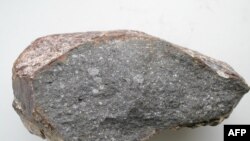Researchers say a rare type of meteor recovered nearly three years ago from a frozen lake in the U.S. state of Michigan has offered one of the best glimpses yet into the organic compounds such objects carry.
A study published in the journal Meteoritics & Planetary Science tells the story of a bright meteor, also known as fireballs for how they light up the night sky, that fell in January 2018.
Researchers say the meteors that shine with such brightness are usually larger and have traveled farther into Earth’s atmosphere without breaking up, raising hopes pieces could be recovered. Using weather radar, they were able to track the meteor’s trajectory, discovering large pieces just two days after it hit a frozen lake.
University of Chicago researcher Philipp Heck said finding the meteorite (what a meteor is called once it lands on Earth) pieces so quickly and on a frozen lake was significant. He said meteors often fall into dirt or water, and if they are not discovered quickly, they can be contaminated by organic Earth material.
The researchers determined they'd found an “H4 chondrite” meteorite. Only 4% of all meteorites falling to Earth are of this type, at least in recent history. Heck said it had “a rich inventory of extraterrestrial organic compounds,” which contain carbon, one of the basic ingredients of life on Earth.
The discovery adds evidence to the widely held theory that compounds such as these — the so-called building blocks of life — were delivered to Earth by similar meteors shortly after Earth formed.
Heck said the discovery of the Michigan meteor and subsequent analysis also helped scientists develop new analytical techniques to study meteors of its kind and gain knowledge that can be shared with other scientists around the world.





